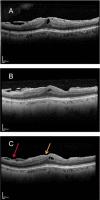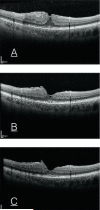CHARACTERISTICS OF EPIRETINAL MEMBRANE REMNANT EDGE BY OPTICAL COHERENCE TOMOGRAPHY AFTER PARS PLANA VITRECTOMY
- PMID: 28590966
- PMCID: PMC5505813
- DOI: 10.1097/IAE.0000000000001466
CHARACTERISTICS OF EPIRETINAL MEMBRANE REMNANT EDGE BY OPTICAL COHERENCE TOMOGRAPHY AFTER PARS PLANA VITRECTOMY
Abstract
Purpose: To evaluate the incidence, characteristics, and the progression of epiretinal membrane (ERM) remnant edge seen by optical coherence tomography after ERM peeling.
Methods: A retrospective chart review was conducted for 86 eyes of 85 consecutive patients who were diagnosed with ERM and underwent pars plana vitrectomy for epiretinal membrane peeling between 2013 and 2014. Data collected and analyzed included age, gender, preoperative and postoperative visual acuity, use of indocyanine green dye to stain internal limiting membrane, tamponade used after vitrectomy, ERM edge boundaries, presence of cystoid macular edema, and central foveal thickness.
Results: An ERM remnant edge was detected in 33/86 study eyes (38.4%) at the first postoperative optical coherence tomography scan. Compared with those without an ERM remnant, patients with an ERM remnant after surgery were significantly older at baseline and had a higher incidence of ERM recurrence at their last visit. They were not significantly different in terms of gender, preoperative and postoperative visual acuity, reduction of central foveal thickness from baseline, proportion of eyes with preoperative ERM elevation on optical coherence tomography, presence of macular edema before surgery, intraoperative use of indocyanine green staining for ILM peeling, or tamponade used. Based on the edge morphology, we classified the ERM remnant into three types: Type 1 was flat and blended with the retina (14/33 eyes, 42.4%), Type 2 was flat but stepped (17/33 eyes, 51.5%), and Type 3 was elevated (2/33 eyes, 6.0%). A significantly higher risk of ERM recurrence was seen in Type 2 and Type 3 ERM remnants (75% and 100%, respectively) than Type 1 ERM remnants (10%).
Conclusion: An ERM remnant edge was detected by optical coherence tomography after ERM peeling in 38.4% of eyes. The presence of a postoperative ERM edge was associated with a higher risk of ERM recurrence, particularly in Type 2 and Type 3 ERM remnants.
Figures



Similar articles
-
THE EFFECT OF INTERNAL LIMITING MEMBRANE PEELING ON IDIOPATHIC EPIRETINAL MEMBRANE SURGERY, WITH A REVIEW OF THE LITERATURE.Retina. 2017 May;37(5):873-880. doi: 10.1097/IAE.0000000000001263. Retina. 2017. PMID: 27617536 Review.
-
Internal Limiting Membrane Peeling to Prevent Post-vitrectomy Epiretinal Membrane Development in Retinal Detachment.Am J Ophthalmol. 2016 Nov;171:1-10. doi: 10.1016/j.ajo.2016.08.015. Epub 2016 Aug 18. Am J Ophthalmol. 2016. PMID: 27544480
-
COMPARATIVE ANALYSIS OF RETINAL REATTACHMENT SURGERY WITH OR WITHOUT INTERNAL LIMITING MEMBRANE PEELING TO PREVENT POSTOPERATIVE MACULAR PUCKER.Retina. 2018 Sep;38(9):1770-1776. doi: 10.1097/IAE.0000000000001775. Retina. 2018. PMID: 28723849
-
Double staining with brilliant blue G and double peeling for epiretinal membranes.Ophthalmology. 2009 Jul;116(7):1370-6. doi: 10.1016/j.ophtha.2009.01.024. Epub 2009 May 8. Ophthalmology. 2009. PMID: 19427701
-
Pars Plana Vitrectomy with or without Internal Limiting Membrane Peel for Epiretinal Membrane: A Systematic Review and Meta-Analysis.Ophthalmologica. 2024;247(1):30-43. doi: 10.1159/000534851. Epub 2023 Oct 28. Ophthalmologica. 2024. PMID: 37899043
Cited by
-
Long-term evaluation of spontaneous release of epiretinal membrane and its possible pathogenesis.Clin Ophthalmol. 2017 Sep 1;11:1607-1610. doi: 10.2147/OPTH.S146692. eCollection 2017. Clin Ophthalmol. 2017. PMID: 28979089 Free PMC article.
-
Long-term Follow-up Results of Idiopathic Epiretinal Membrane Removal in the Eyes with Ectopic Inner Foveal Retinal Layers.Middle East Afr J Ophthalmol. 2024 Jun 14;30(2):72-79. doi: 10.4103/meajo.meajo_51_24. eCollection 2023 Apr-Jun. Middle East Afr J Ophthalmol. 2024. PMID: 39006936 Free PMC article.
-
Comparison of Idiopathic Macular Hole Interventions Using Frequency Domain Optical Coherence Tomography and Optical Coherence Tomography Angiography.Dis Markers. 2022 Aug 13;2022:7749605. doi: 10.1155/2022/7749605. eCollection 2022. Dis Markers. 2022. PMID: 35996716 Free PMC article.
-
[Statement of the Professional Association of German Ophthalmologists (BVA), the German Ophthalmological Society (DOG) and the Retinological Society (RG) on the development, diagnostics and treatment of epiretinal gliosis : Status October 2020].Ophthalmologe. 2021 Feb;118(2):121-138. doi: 10.1007/s00347-020-01291-3. Ophthalmologe. 2021. PMID: 33346894 Review. German. No abstract available.
-
Persistence and recurrence after removal of idiopathic epiretinal membrane.Eye (Lond). 2025 Feb;39(2):314-319. doi: 10.1038/s41433-024-03429-y. Epub 2024 Oct 25. Eye (Lond). 2025. PMID: 39455899 Free PMC article.
References
-
- Mitchell P, Smith W, Chey T, et al. Prevalence and associations of epiretinal membranes. The Blue Mountains Eye Study, Australia. Ophthalmology. 1997;104:1033–1040. - PubMed
-
- You Q, Xu L, Jonas JB. Prevalence and associations of epiretinal membranes in adult Chinese: the Beijing eye study. Eye (Lond) 2008;22:874–879. - PubMed
-
- Gass JDM. Macular dysfunction caused by epiretinal membrane contraction. Stereoscopic Atlas of Macular Diseases: Diagnosis and Treatment. 1997:938–950.
-
- Park DW, Dugel PU, Garda J, et al. Macular pucker removal with and without internal limiting membrane peeling: pilot study. Ophthalmol. 2003;110:62–64. - PubMed
MeSH terms
Grants and funding
LinkOut - more resources
Full Text Sources
Other Literature Sources
Medical
Miscellaneous

